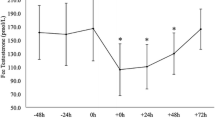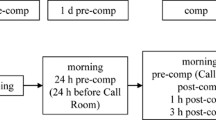Abstract
Rock climbing is rapidly increasing in popularity as a recreational activity and as a competitive sport. Few studies have tested acute physiological responses to climbing, and no studies to date have tested hormone responses to a climbing-based workout. This study aimed to measure testosterone (T), growth hormone (GH), and cortisol (C) responses to continuous vertical climbing in young male rock climbers. Ten male rock climbers, aged between 21 and 30 years, climbed laps on a submaximal 55′ climbing route for 30 min, or until exhaustion, whichever came first. Heart rate (HR) was recorded after every lap. Blood samples were collected by venipuncture before (Pre), immediately post (IP), and 15 min after the climbing exercise (P15) to assess blood lactate and plasma GH, T, and C. Subjects climbed 24.9 ± 1.9 min and 507.5 ± 82.5 feet. Peak HR was 182.1 ± 2.3 bpm, and lactate (Pre: 2.9 ± 0.6 mmol/dL, IP: 11.1 ± 1.0 mmol/dL) significantly (P < 0.05) increased from Pre to IP. T concentrations significantly (P < 0.05) increased from Pre (6.04 ± 0.31 ng/mL) to IP (7.39 ± 0.40 ng/mL) and returned to baseline at P15 (6.23 ± 0.33 ng/mL). Cortisol levels did not significantly change during the protocol. GH significantly (P < 0.01) increased from Pre (0.63 ± 0.17 ng/mL) to IP (19.89 ± 4.53 ng/mL) and remained elevated at P15 (15.03 ± 3.89 ng/mL). An acute, short-term bout of high-intensity continuous climbing was an effective exercise stimulus for elevating plasma testosterone and growth hormone levels in young males.


Similar content being viewed by others
References
Bertuzzi RC, Franchini E, Kokubun E, Kiss MA (2007) Energy system contributions in indoor rock climbing. Eur J Appl Physiol 101:293–300
Bhasin S (2008) Testicular disorders. In: Kronenberg HM, Melmed S, Polonsky KS, Larsen PR (eds) Williams textbook of endocrinology, 11th edn. Saunders Elsevier, Philadelphia, pp 645–699
Billat V, Palleja P, Charlaix T, Rizzardo P, Janel N (1995) Energy specificity of rock climbing and aerobic capacity in competitive sport rock climbers. J Sports Med Phys Fitness 35:20–24
Bloom SR, Johnson RH, Park DM, Rennie MJ, Sulaiman WR (1976) Differences in the metabolic and hormonal response to exercise between racing cyclists and untrained individuals. J Physiol 258:1–18
Booth J, Marino F, Hill C, Gwinn T (1999) Energy cost of sport rock climbing in elite performers. Br J Sports Med 33:14–18
Bunt JC, Boileau RA, Bahr JM, Nelson RA (1986) Sex and training differences in human growth hormone levels during prolonged exercise. J Appl Physiol 61(5):1796–1801
de Geus B, O’Driscoll SV, Meeusen R (2006) Influence of climbing style on physiological responses during indoor rock climbing on routes with the same difficulty. Eur J Appl Physiol 98:489–496
Durand SJ, Castracane VD, Hollander DB, Tryniecki JL, Bamman MM, O'Neal S, Hebert EP, Kraemer RR (2003) Hormonal responses from concentric and eccentric muscle contractions. Med Sci Sports Exerc 35(6):937–943
Espana-Romero V, Ortega Porcel FB, Artero EG, Jimenez-Pavon D, Sainz AG, Castillo Garzon MJ, Ruiz JR (2009) Climbing time to exhaustion is a determinant of climbing performance in high-level sport climbers. Eur J Appl Physiol 107:517–525
Fritzsche RG, Switzer TW, Hodgkinson BJ, Coyle EF (1999) Stroke volume decline during prolonged exercise is influenced by the increase in heart rate. J Appl Physiol 86:799–805
Galbo H, Hummer L, Petersen IB, Christensen NJ, Bie N (1977) Thyroid and testicular hormone responses to graded and prolonged exercise in men. Eur J Appl Physiol 36:101–106
Godfrey RJ, Madgwick Z, Whyte GP (2003) The exercise-induced growth hormone response in athletes. Sports Med 33(8):599–613
Goodman HM (2009) Basic medical endocrinology, 4th edn. Academic Press, Burlington
Hague DM, Hunter D (2006) The self coached climber: the guide to movement training performance. Stackpole Books, Mechanicsburg
Heyman E, de Geus B, Mertens I, Meeusen R (2009) Effects of four recovery methods on repeated maximal rock climbing performance. Med Sci Sports Exerc 41(6):1303–1310
Hodgson CI, Draper N, McMorris T, Jones G, Fryer S, Coleman I (2009) Perceived anxiety and plasma cortisol concentrations following rock climbing with differing safety-rope protocols. Br J Sports Med 43(7):531–535
Izquierdo M, Ibañez J, Calbet JAL, Navarro-Amezqueta I, González-Izal M, Idoate F et al (2009) Cytokine and hormone responses to resistance training. Eur J Appl Physiol 107:397–409
Jensen J, Oftebro H, Breigan B, Johnsson A, Öhlin K, Meen HD, Strømme SB, Dahl HA (1991) Comparison of changes in testosterone concentrations after strength and endurance exercise in well trained men. Eur J Appl Physiol 63:467–471
Judelson DA, Maresh CM, Yamamoto LM, Farrell MJ, Armstrong LE, Kreamer WJ, Volek JS, Spiering BA, Casa DJ, Anderson JM (2008) Effect of hydration state on resistance exercise-induced endocrine markers of anabolism, catabolism and metabolism. J Appl Physiol 105:816–824
Kanaley JA, Weltman JY, Veldhuis JD, Rogol AD, Hartman ML, Weltman A (1997) Human growth hormone response to repeated bouts of aerobic exercise. J Appl Physiol 83(5):1756–1761
Karkoulias K, Habeos I, Charokopos N, Tsiamita M, Mazarakis A, Pouli A, Spiropoulos K (2008) Hormonal responses to marathon running in non-elite athletes. Eur J Int Med 19:598–601
Kraemer WJ, Ratamess NA (2005) Hormonal responses and adaptations to resistance exercise and training. Sports Med 35(4):339–361
Kraemer RR, Hollander DB, Reeves GV, Francois M, Ramadan ZG, Meeker B, Tryniecki JL, Hebert EP, Castracane VD (2006) Similar hormonal responses to concentric and eccentric muscle actions using relative loading. Eur J Appl Physiol 96:551–557
Linnamo V, Pakarinen A, Komi PV, Kraemer WJ, Hakkinen K (2005) Acute hormonal responses to submaximal and maximal heavy resistance and explosive exercises in men and women. J Strength Cond Res 19(3):566–571
Lu S-S, Lau C-P, Tung Y-F, Huang S-W, Chen Y-H, Shih H-C, Tsai S-C, Lu C-C, Wang S-W, Chen J-J, Chien EJ, Chien C-H, Wang PS (1997) Lactate and the effects of exercise on testosterone secretion: evidence for the involvement of a cAMP-mediated mechanism. Med Sci Sports Exerc 29(8):1048–1054
Mermier CM, Robergs RA, McMinn SM, Heyward VH (1997) Energy expenditure and physiological responses during indoor rock climbing. Br J Sports Med 31:224–228
Mermier CM, Janot JM, Parker DL, Swan JG (2000) Physiological and anthropometric determinants of sport climbing performance. Br J Sports Med 34:359–365
Nagel D, Seiler D, Franz H (1992) Biochemical, hematological and endocrinological parameters during repeated intense short-term running in comparison to ultra-long-distance running. Int J Sports Med 13(4):337–343
Pendergast DR (1989) Cardiovascular, respiratory, and metabolic responses to upper body exercise. Med Sci Sports Exerc 21(5 Suppl):S121–S125
Rodio A, Fattorini L, Rosponi A, Quattrini FM, Marchetti M (2008) Physiological adaption in noncompetitive rock climbers: good for aerobic fitness? J Strength Cond Res 22(2):359–364
Schmid P, Pusch HH, Wolf W, Pilger E, Pessenhofer H, Schwaberger G, Pristautz H, Purstner P (1982) Serum FSH, LH, and testosterone in humans after physical exercise. Int J Sports Med 3:84–89
Sheel AW, Seddon N, Knight A, McKenzie DC, Warburton DER (2003) Physiological responses to indoor rock-climbing and their relationship to maximal cycle ergometry. Med Sci Sports Exerc 35(7):1225–1231
Smilios I, Pilianidis T, Karamouzis M, Tokmakidis SP (2003) Hormonal responses after various resistance exercise protocols. Med Sci Sports Exerc 35(4):644–654
Van Beaumont (1972) Evaluation of hemoconcentration from hematocrit measurements. J Appl Physiol 32(5):712–713
Viru A (1992) Plasma hormones and physical exercise. Int J Sports Med 13(3):201–209
Viru A, Karelson K, Smirnova T (1992) Stability and variability in hormonal responses to prolonged exercise. Int J Sports Med 13(3):230–235
Viru A, Viru M, Karelson K, Janson T, Siim K, Fischer K, Hackney AC (2007) Adrenergic effects on adrenocortical cortisol response to incremental exercise to exhaustion. Eur J Appl Physiol 100:241–245
Wall CB, Starek JE, Fleck SJ, Byrnes WC (2004) Prediction of indoor climbing performance in women rock climbers. J Strength Cond Res 18:77–83
Watts PB, Joubert LM, Lish AK, Mast JD, Wilkins B (2003) Anthropometry of young competitive sport rock climbers. Br J Sports Med 37:420–424
Webb ML, Wallace JP, Hamill C, Hodgson JL, Mashaly MM (1984) Serum testosterone concentration during two hours of moderate intensity treadmill running in trained men and women. Endocr Res 10(1):27–38
Acknowledgments
This study was funded through the University of Oklahoma College of Arts and Sciences Faculty Enrichment Grant, Graduate College Robberson Research Grant, and Graduate Student Senate Research Grant. We would like to thank L. Kathleen Cargill, Alina Joaca-Bine, Bethany James, Carmen Chrisman, and Jessica Smith for their assistance in data collection. We would also like to acknowledge and thank Aaron Gibson and Rocktown Climbing Gym for allowing us to conduct our research in their gym. Finally, thank you to the climbers that participated or belayed in the study.
Author information
Authors and Affiliations
Corresponding author
Additional information
Communicated by Susan Ward.
Rights and permissions
About this article
Cite this article
Sherk, V.D., Sherk, K.A., Kim, S. et al. Hormone responses to a continuous bout of rock climbing in men. Eur J Appl Physiol 111, 687–693 (2011). https://doi.org/10.1007/s00421-010-1685-2
Accepted:
Published:
Issue Date:
DOI: https://doi.org/10.1007/s00421-010-1685-2




